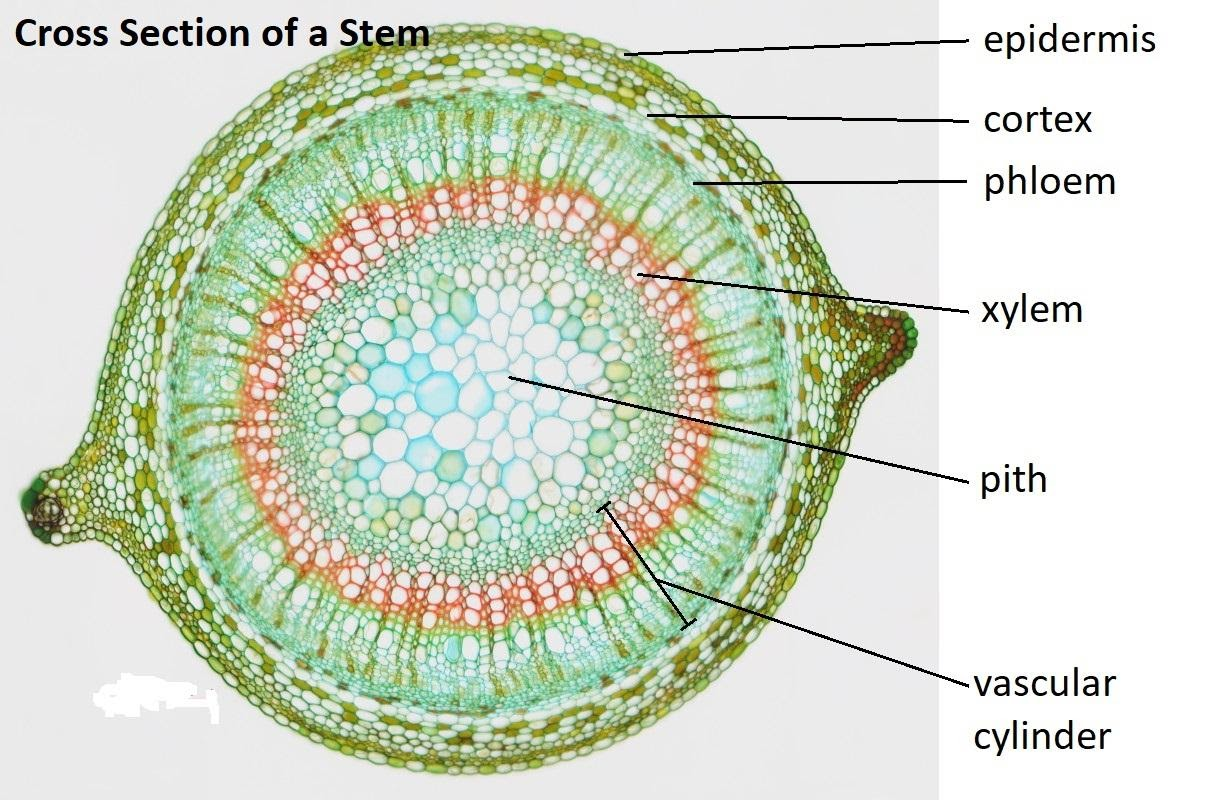
Is the pith of plants ground tissue?
Answer
463.5k+ views
Hint: Ground tissue in the plants is inclusive of tissues, which are neither vascular nor dermal. The ground tissue system arises from the ground tissue meristem. Based on the nature of the cell walls, the ground tissue is divided into three types, namely, parenchyma, sclerenchyma, and collenchyma. Ground tissue surrounds the pericycle and vascular cylinder.
Complete answer:

Fig: Internal Anatomy of Stem
As the pith of plants is composed of parenchyma cells, it is ground tissue.
Pith is present in the central portion of the stem. The cells of the pith are rounded in shape, with large intercellular spaces. The cells of the pith, which are present between the vascular bundles, constitute the pith rays, which are otherwise known as medullary rays. As the parenchyma cells are radially arranged in between the bundles, the arrangement provides the appearance of rays. These pith rays aid in the radial conduction of food. Pith offers structure to the stem at the center.
Pith performs storage of food. So the cells are unspecialized since storage is not an active function. The tissue exists and stores different substances. It is the central parenchyma cell in the stem and is primarily used for storage.
In the dicot root, the xylem and phloem form an X-shape at the center of the root, while in the monocot root, the phloem and the xylem form a characteristic ring around the pith. Thus, the center of the monocot root is filled with pith.
Note:
When the ground tissue is present in the root center, it is the pith. At the same time, when the ground tissue is present at the root periphery, it is the cortex. Parenchyma aids in the photosynthesis of leaves and storage in roots. Collenchyma provides support to the shoot in areas of active growth. Sclerenchyma displays support for the shoot in the areas where the growth has ceased.
Complete answer:

Fig: Internal Anatomy of Stem
As the pith of plants is composed of parenchyma cells, it is ground tissue.
Pith is present in the central portion of the stem. The cells of the pith are rounded in shape, with large intercellular spaces. The cells of the pith, which are present between the vascular bundles, constitute the pith rays, which are otherwise known as medullary rays. As the parenchyma cells are radially arranged in between the bundles, the arrangement provides the appearance of rays. These pith rays aid in the radial conduction of food. Pith offers structure to the stem at the center.
Pith performs storage of food. So the cells are unspecialized since storage is not an active function. The tissue exists and stores different substances. It is the central parenchyma cell in the stem and is primarily used for storage.
In the dicot root, the xylem and phloem form an X-shape at the center of the root, while in the monocot root, the phloem and the xylem form a characteristic ring around the pith. Thus, the center of the monocot root is filled with pith.
Note:
When the ground tissue is present in the root center, it is the pith. At the same time, when the ground tissue is present at the root periphery, it is the cortex. Parenchyma aids in the photosynthesis of leaves and storage in roots. Collenchyma provides support to the shoot in areas of active growth. Sclerenchyma displays support for the shoot in the areas where the growth has ceased.
Recently Updated Pages
Master Class 12 Business Studies: Engaging Questions & Answers for Success

Master Class 12 Economics: Engaging Questions & Answers for Success

Master Class 12 English: Engaging Questions & Answers for Success

Master Class 12 Maths: Engaging Questions & Answers for Success

Master Class 12 Social Science: Engaging Questions & Answers for Success

Master Class 12 Chemistry: Engaging Questions & Answers for Success

Trending doubts
What is meant by exothermic and endothermic reactions class 11 chemistry CBSE

Which animal has three hearts class 11 biology CBSE

10 examples of friction in our daily life

One Metric ton is equal to kg A 10000 B 1000 C 100 class 11 physics CBSE

1 Quintal is equal to a 110 kg b 10 kg c 100kg d 1000 class 11 physics CBSE

Difference Between Prokaryotic Cells and Eukaryotic Cells




